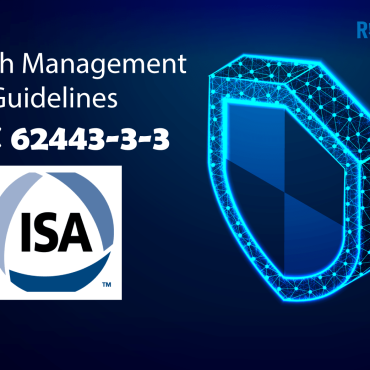Industrial Control Systems (ICSs)
An industrial control system is a wide range of automation systems used to provide monitoring functionality and control in industrial facilities. An ICS is basically a collection of a variety of systems, including process control systems (PCS), supervisor control and data acquisition (SCADA), distributed control systems (DCS), safety instrumented systems (SIS), and many more. These systems are used for several kinds of social infrastructure and play a vital role in ensuring their safety and realizing control functions.
Industrial control systems leverage open architectures, often connected to external systems, such as office systems. Moreover, these systems include safety instrumented systems (SIS), hardened information components built for high reliability. The goal of industrial control systems is to make regular operations autonomous and more efficient with less or no human intervention.
What is ICS Patch Management?
A patch management program is focused on safe procurement, deployment, testing, and implementation of trusted patches to keep ICS more secure. It helps to ensure that the industrial control system is up to date and is protected against hackers and malicious users. It is applicable for all software and hardware components of ICS in both Operational Technology (OT) and Information Technology (IT). Patches are essential for resolving security vulnerabilities and issues. ICSs are essentially leveraged in mission-critical infrastructure for monitoring and controlling remotely scattered systems efficiently. These systems are high-risk targets for exploitations and attacks, posing severe security challenges for ICS asset owners and vendors. Important parts of ICS patch management include
- Configuration management
- Creating accustomed baselines of systems
- Latest inventory for both OT and IT software and hardware
- Identifying patches for software and hardware
- Assessing complexity of patches
- Patch test before implementation
- Getting updates for authentication vendors
- Ensuring security
- Preparing backup
Importance of patch management in ICS environment
It is challenging to address critical security flaws, particularly in OS-based devices within the ICS network. In the past few years, ransomware attacks spanning industrial processes have targeted various industries. The ransomware spread because of unpatched systems on OT and IT environments. While conducting ICS network assessments, you will find multiple devices with unpatched critical vulnerabilities, allowing ransomware or other malware to infiltrate.
Many OT systems are insecure by design, which would open doors for criminals even after vulnerability patching. Many commodity hacks do not take advantage of these vulnerable systems but instead use known flaws for causing disruption. Patch management can be used in the following categories for providing a robust security environment.
- It can enable security features, such as encrypted authentication or add s MFA
- Security specific, such as for fixing security flaws in the ICS environment
- Functional fix, such s, stability or feature update.
How to implement patch management to improve ICS security?
Industrial control systems have evolved from isolated systems to large interconnected networks. This evolvement has made them more vulnerable to potential cyber threats. A system can become more vulnerable by running older or unpatched software versions and putting your organization’s security at risk. However, the security of these devices can be improved by implementing patch management. Here are steps to implement patch management in industrial control systems for optimized security.
1. Information gathering
With the evolved cyber world, new security vulnerabilities are discovered and published daily. Patch management is important for providing ways to mitigate system vulnerabilities. Usually, vendors publish security advisories on their websites when they discover or patch a new vulnerability. You should gather information on the latest known patches. It will help you keep track of your asset vulnerabilities.
2. Evaluate/Assess
It is often difficult to choose which patch needs to be applied. Patches are changes that can impact the safety, reliability, or performance of OT systems. Sometimes, applying a patch can make other applications in your system incompatible and causes issues, such as the vendor no longer providing support. Some vendors give a compatibility list, and it’s a good practice to assess your system specifications and compatibility list before applying a patch.
3. Test
It is suggested to test a patch before applying it to the system. A patch test can be done in multiple ways, such as
- Setting up a separate test environment using the same software and hardware and then applying a patch.
- Simulating the environment with virtual machines
- Testing the patch on a redundant system first so that there is a backup if the patch test fails.
4. Deploy
Most ICSs run 24/7 and require high availability. However, applying a patch can cause downtime as the component need to reboot, making it harder to implement efficient patch management. A good practice is to implement planned maintenance with a patch application.
5. Document pre and post patching
One of the most managerial tasks regarding patch management is to document the baseline systems before and after applying a patch. Any changes to the baseline should be captured and listed in the corporate change management workflows to secure the latest configuration and maintain compliance. After applying a patch, verify that it is applied successfully. Moreover, documenting the patching process shows that proper measures are taken to mitigate known flaws if a cyber incident occurs.
Simplify ICS Patch Management Process
However, ICS patch management seems a simple operation, but it is a time-consuming and difficult task. The time and effort burden can be huge without automatic collection and monitoring tools. Moreover, manual tasks are more prone to vulnerabilities and increase the effort and time to rework, thus introducing security risks to industrial control systems. It is recommended to use automated procedures for patch management. The patching solutions need to be flexible and scalable based on clients’ requirements.










Post comments (0)